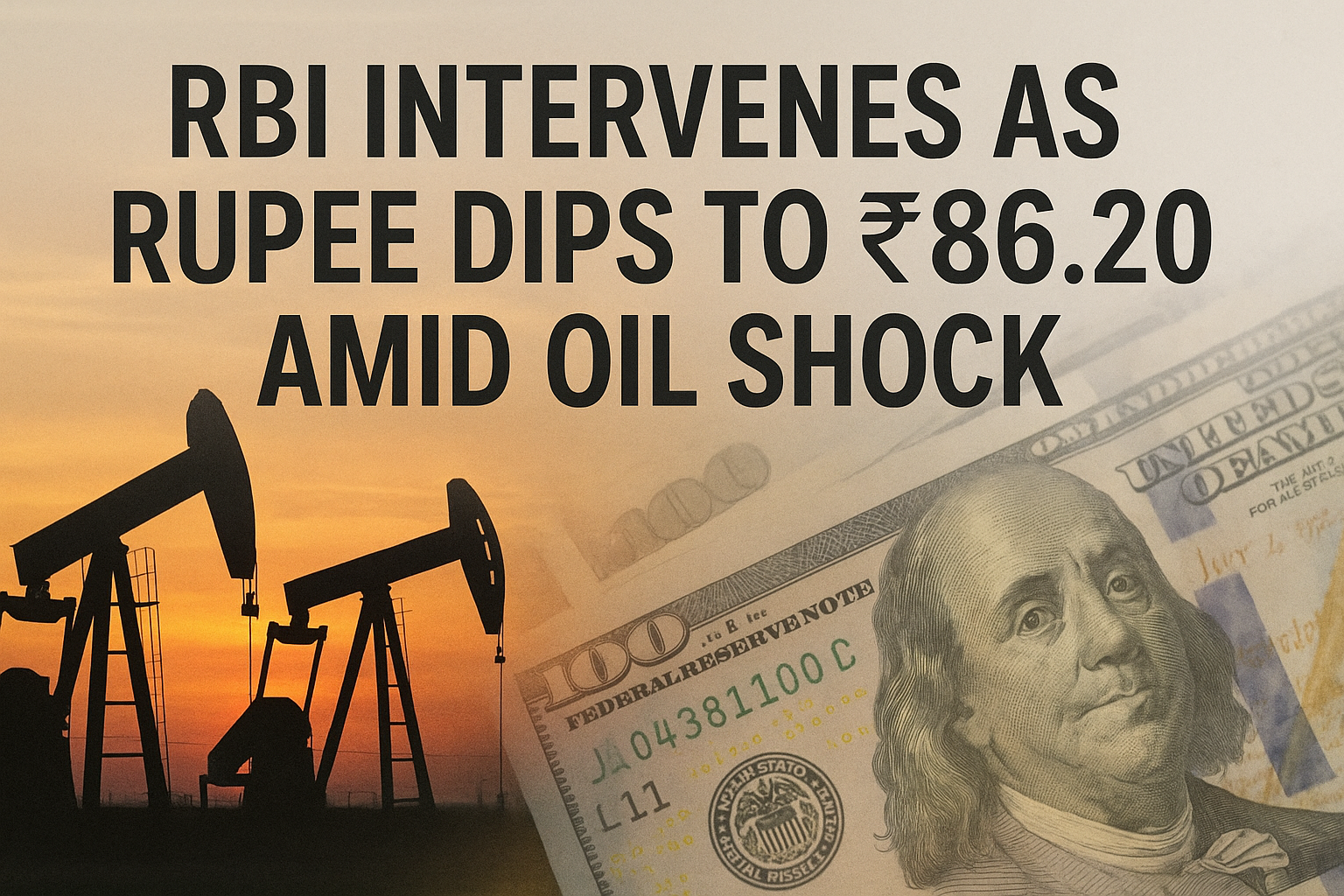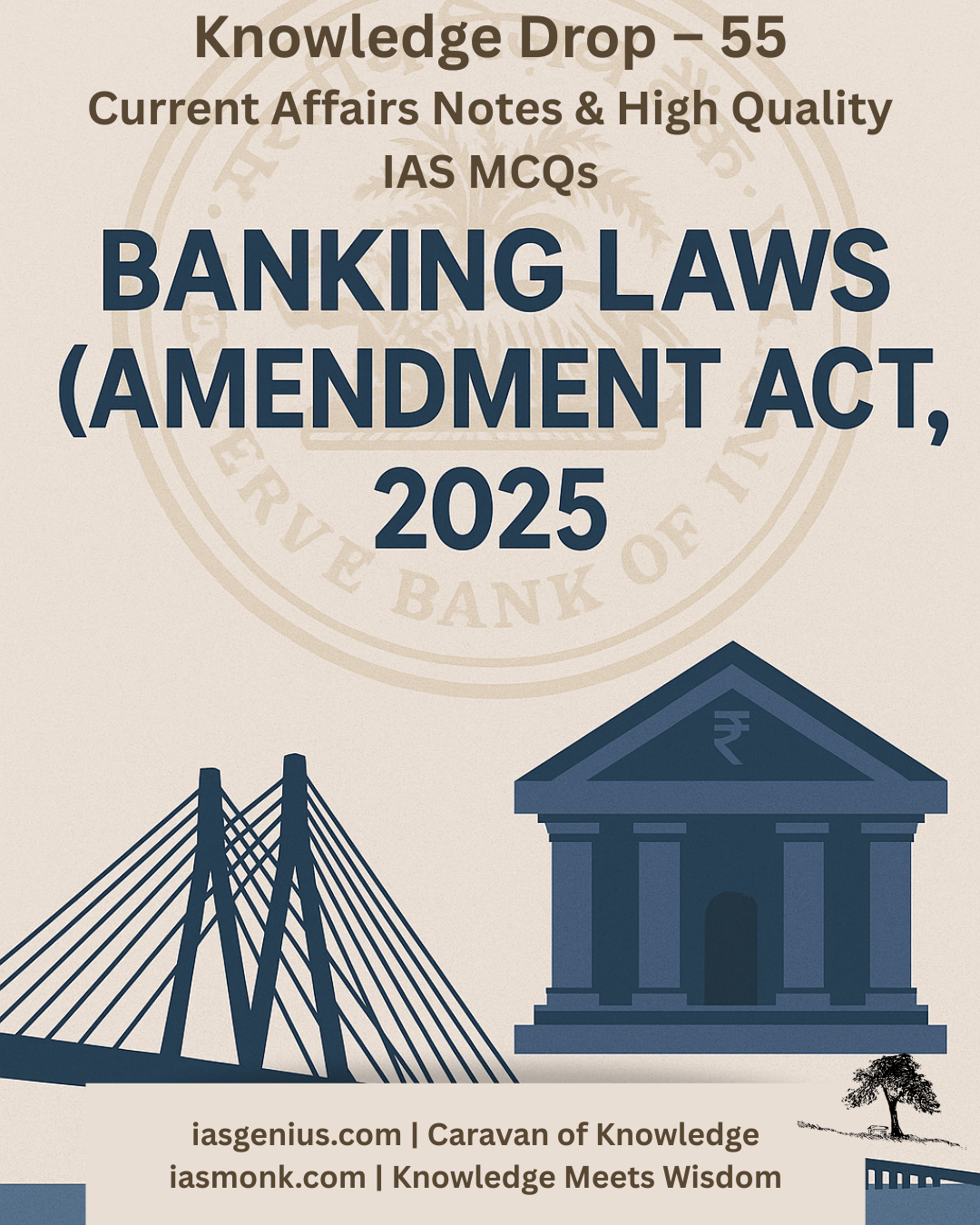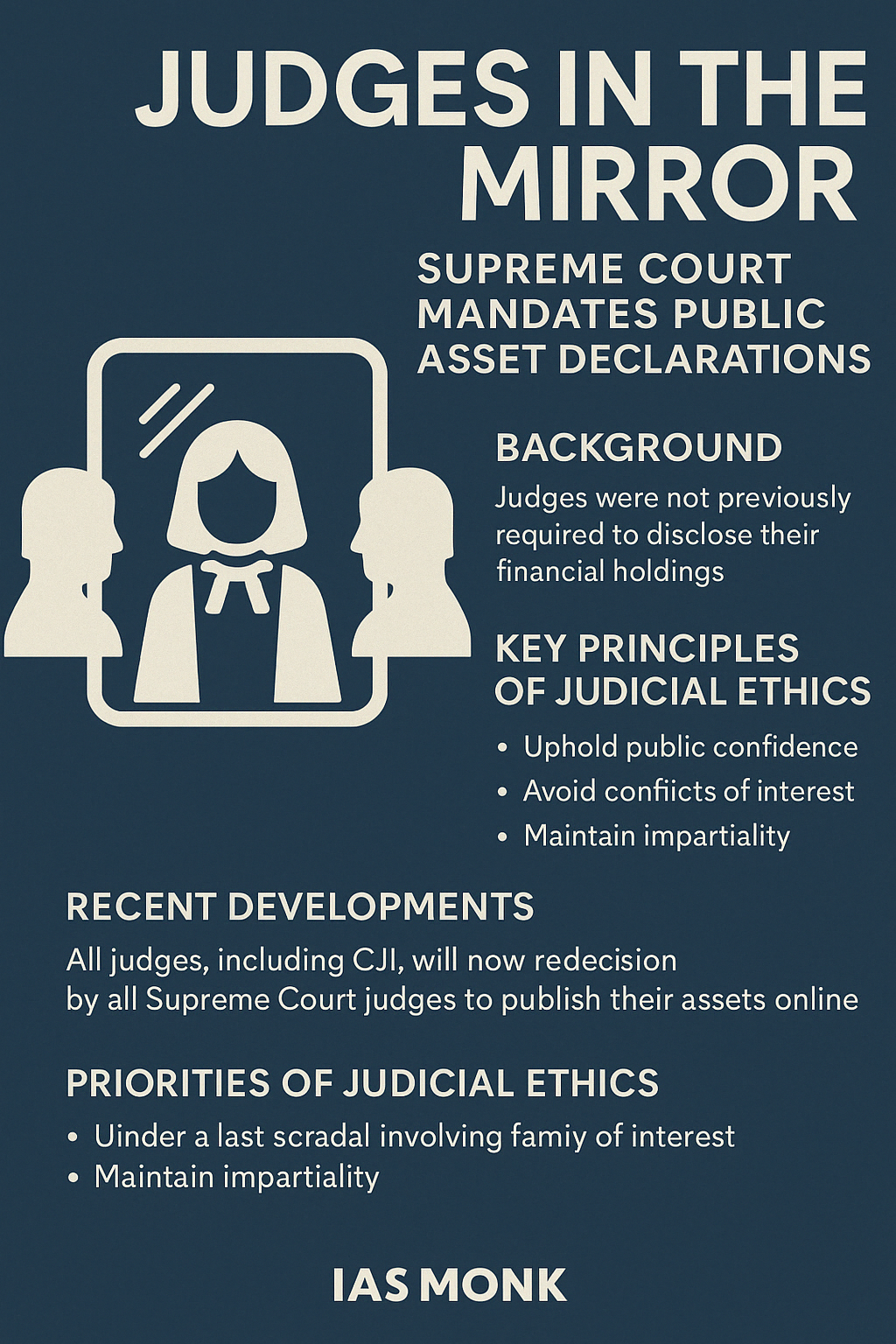
🧭June 13, 2025 Post 1: RBI Intervenes as Rupee Dips to ₹86.20 amid Oil Shock | High Quality Mains Essay | Prelims MCQs
RBI Intervenes as Rupee Dips to ₹86.20 amid Oil Shock

NATIONAL
Post Date: June 13, 2025
Thematic Focus: Economy | FX Policy | Energy-Trade Linkages
🌀 Opening Whisper
“When the oil flares high, currencies begin to sway—quiet hands must steady the storm.”
🔍 Key Highlights
- The Indian rupee depreciated to ₹86.20/USD, marking its lowest level in 15 months, triggered by a sharp 11% spike in global crude oil prices.
- The oil surge follows escalating tensions in the Middle East, affecting Brent prices which crossed $101/barrel.
- The Reserve Bank of India (RBI) reportedly intervened via state-run banks, selling U.S. dollars to prevent excessive volatility in the foreign exchange market.
- The intervention took place against the backdrop of a comfortable forex reserve position and an anticipated rise in import bills.
- India, as a major net oil importer, remains highly sensitive to global oil shocks, especially when the current account is under strain.
- This marks RBI’s third FX intervention in June, signaling a cautious approach to inflation control and currency stability.
📘 Concept Explainer: Why This Matters
- A weakening rupee increases imported inflation, especially through crude oil, which affects transport, energy, and food prices.
- FX interventions are meant to smooth volatility, not fix the exchange rate permanently.
- RBI’s action highlights a policy dilemma—balancing inflation control, currency management, and external trade competitiveness.
🧭 GS Mains Mapping
- GS Paper 3 – Indian Economy: External Sector, Currency Market, Inflation Control
- GS Paper 2 – Role of RBI in Policy Stabilization
- GS Paper 1 – Impact of Global Events on Indian Economy
✨ A Thought Spark — by IAS Monk
In the rhythm of oil and rupee, a nation’s calm is measured not by the storm, but by the silent guardians who steady its pulse.
High Quality Mains Essay For Practice :
Word Limit 1000-1200
Currencies in Crisis: RBI’s Intervention and India’s Foreign Exchange Policy at a Crossroads
Introduction
The rupee is more than a medium of exchange—it is a reflection of national stability, international confidence, and economic sovereignty. On June 13, 2025, the Indian rupee slipped to ₹86.20 per USD, its lowest in over a year, in response to a sudden 11% surge in global crude oil prices triggered by escalating tensions in the Middle East. The Reserve Bank of India (RBI) stepped in with quiet urgency, deploying state-run banks to stabilize the exchange rate by selling dollars.
This episode, though brief, is emblematic of the fragile dance between global volatility and domestic policy resilience. It places the spotlight on RBI’s evolving role as a currency stabilizer, India’s vulnerability to oil shocks, and the broader implications for inflation, fiscal health, and monetary credibility. This essay explores the causes, policy responses, and future roadmap for India’s foreign exchange management in a world of constant economic tremors.
The Immediate Trigger: Crude Oil Shock and the Currency Spiral
1. Global Oil Price Surge
- A sharp geopolitical escalation in the Middle East (closure of Red Sea trade routes and drone attacks on tankers) led Brent crude to breach $101 per barrel.
- As a net oil importer, India is among the most vulnerable major economies to global energy price swings. Oil accounts for nearly 25% of India’s import bill.
2. Rupee Depreciation
- The rupee weakened sharply from ₹84.90 to ₹86.20/USD within 48 hours.
- This decline was driven by higher anticipated current account deficits, panic among portfolio investors, and a global flight to the U.S. dollar.
RBI’s Response: Currency Stabilization without Panic
The RBI’s forex policy has historically followed the principle of “managing volatility, not the level”. In this instance:
A. Direct Dollar Sales
- The RBI deployed state-run banks to sell U.S. dollars in the spot market, absorbing speculative pressure and reducing panic.
- Market participants confirmed $3–4 billion was offloaded over two trading sessions.
B. Signal of Confidence
- No official press release was issued—consistent with RBI’s preference for discreet action to avoid market overreaction.
- By intervening early and visibly, RBI signaled its intent to prevent a free fall.
C. Maintaining Policy Credibility
- With inflation declining (CPI at 2.82%), RBI is cautious not to reverse its recent rate-cut stance due to imported price pressures.
- Intervention thus becomes a tool of inflation targeting, rather than just FX smoothing.
Impact on the Broader Economy
1. Inflation
- A weaker rupee increases the cost of imported items—particularly oil, electronics, fertilizers, and edible oils.
- RBI’s move prevents this transmission from turning into generalized inflation, which could force monetary tightening.
2. Trade Deficit
- Higher oil prices may push the monthly trade deficit beyond USD 25 billion, raising pressure on the current account.
- Intervention helps moderate this by reducing speculative import hoarding of crude and commodities.
3. Investor Confidence
- Stable currency fosters confidence among Foreign Portfolio Investors (FPIs) and sovereign bond buyers, both critical for India’s capital account health.
Why Currency Stability Matters for India
• Inflation Targeting
With inflation now the primary mandate of monetary policy, FX management becomes an indirect lever of price stability.
• Global Investment Strategy
India is becoming a destination for friend-shoring and supply chain relocation. A stable rupee signals low currency risk.
• Import-Export Planning
For MSMEs and exporters, sudden currency spikes disrupt pricing models, raise input costs, and hurt competitiveness.
• Geopolitical Soft Power
A volatile currency can reduce India’s leverage in bilateral trade deals and debt diplomacy.
Historical Context: Lessons from the Past
• 2013 Taper Tantrum
When U.S. Fed hinted at ending stimulus, rupee plummeted from ₹55 to ₹69. RBI had to deploy capital controls, restrict gold imports, and raise interest rates.
• 2018 Oil Spike
When Brent crossed $85, the rupee fell to ₹74. RBI interventions then helped stabilize macro indicators before elections.
Lesson: Early, transparent, and credible interventions pay off in the long term.
How RBI Manages the Forex Market
1. Spot Market Intervention
Buying/selling USD to manage volatility, often via public sector banks.
2. Forwards and Swaps
RBI uses currency forwards and swap auctions to influence expectations without draining reserves.
3. Moral Suasion
Engaging with traders and importers to dissuade panic hoarding or speculation.
4. Open Market Operations
Indirectly controlling rupee liquidity by buying/selling government bonds.
The Challenge Ahead: Structural Vulnerabilities
• High Import Dependency
- Over 85% of India’s crude oil is imported.
- 40% of electronics and 50% of fertilizers are externally sourced.
• Narrow Export Basket
- Petroleum, IT, and pharma dominate exports. Any external demand shock hits hard.
• Incomplete Hedging Culture
- Indian corporates and MSMEs often don’t hedge currency exposure, amplifying risks.
Recommendations: A Future-Ready FX Strategy
1. Deepen Forex Reserves
- India’s reserves (~USD 610 billion) are adequate for now, but must grow with GDP and trade size.
2. Build Hedging Ecosystems
- Encourage affordable and simple forex derivatives for small exporters.
3. Promote INR Trade Settlements
- Push for rupee-denominated trade with friendly nations to reduce dollar dependency.
4. Strengthen Energy Strategy
- Accelerate green hydrogen, strategic reserves, and crude purchase diversification to reduce oil-linked rupee risks.
Conclusion
The RBI’s swift intervention on June 13, 2025, is a case study in pre-emptive, measured economic management. While global forces continue to buffet the Indian economy, the institutional ability to respond calmly and effectively is India’s true monetary asset.
A volatile rupee can undermine confidence, derail fiscal targets, and fuel inflation. But a transparent, disciplined FX management policy—backed by deep reserves and steady intent—can ensure the rupee remains a symbol of credibility, not fragility.
As oil heats up, it is not the fire, but the firmness of the hand that holds the economy steady.
Target IAS-26: Daily MCQs :
📌 Prelims Practice MCQs
Topic:RBI Intervenes as Rupee Dips to ₹86.20 amid Oil Shock
MCQ 1 – Type 1: How many of the above statements are correct?
Consider the following statements regarding RBI’s forex intervention on June 13, 2025:
1. The RBI sold U.S. dollars in the forex market through state-run banks to stabilize the rupee.
2. The intervention was triggered by an 11% drop in global crude oil prices.
3. The rupee fell to ₹86.20 per USD, marking a 15-month low.
4. RBI’s foreign exchange policy aims to permanently fix the exchange rate at a desired level.
How many of the above statements are correct?
A) Only two
B) Only three
C) All four
D) Only one
🌀 Didn’t get it? Click here (▸) for the Correct Answer & Explanation
✅ Correct Answer: A) Only two
🧠 Explanation:
•1) ✅ True – RBI did intervene via state-run banks.
•2) ❌ False – The intervention was triggered by a sharp rise, not a drop, in global crude oil prices.
•3) ✅ True – The rupee indeed fell to ₹86.20, a 15-month low.
•4) ❌ False – RBI’s stated policy is to manage volatility, not fix the exchange rate.
✅ So, only Statements 1 and 3 are correct → hence, Answer: A) Only two
MCQ 2 – Type 2: Two Statements Based
Consider the following two statements:
1. A weakening rupee generally makes Indian exports more competitive in global markets.
2. RBI intervenes in the forex market to ensure stability and prevent excessive short-term volatility.
Which of the above statements is/are correct?
A) Only 1 is correct
B) Only 2 is correct
C) Both are correct
D) Neither is correct
🌀 Didn’t get it? Click here (▸) for the Correct Answer & Explanation
✅ Correct Answer: C) Both are correct
🧠 Explanation:
•1) ✅ True – A weaker rupee reduces the dollar price of Indian goods abroad.
•2) ✅ True – RBI follows a policy of managing volatility, not pegging.
MCQ 3 – Type 3: Which of the statements is/are correct?
Which of the following are potential consequences of a sharp rupee depreciation?
1. Increase in imported inflation
2. Rise in current account deficit
3. Boost in dollar earnings for exporters
4. Improvement in domestic gold production
Select the correct answer using the code below:
A) 1, 2 and 3 only
B) 2, 3 and 4 only
C) 1 and 4 only
D) 1, 2, 3 and 4
🌀 Didn’t get it? Click here (▸) for the Correct Answer & Explanation
✅ Correct Answer: A) 1, 2 and 3 only
🧠 Explanation:
•1) ✅ True – Cost of imports like oil rises.
•2) ✅ True – Import-heavy trade worsens CAD.
•3) ✅ True – Exporters earn more in rupee terms.
•4) ❌ False – Currency value does not affect mineral production.
MCQ 4 – Type 4: Direct Fact
Which of the following best describes the RBI’s stated approach to managing the rupee?
A) Targeting a fixed exchange rate of ₹85/USD
B) Pegging the rupee to a currency basket
C) Allowing market-determined rates but managing excess volatility
D) Devaluing the rupee during high trade deficits
🌀 Didn’t get it? Click here (▸) for the Correct Answer & Explanation.
✅ Correct Answer: C) Allowing market-determined rates but managing excess volatility
🧠 Explanation:
• •RBI follows a managed float regime where the rupee is not pegged but RBI steps in when volatility becomes disruptive.

















